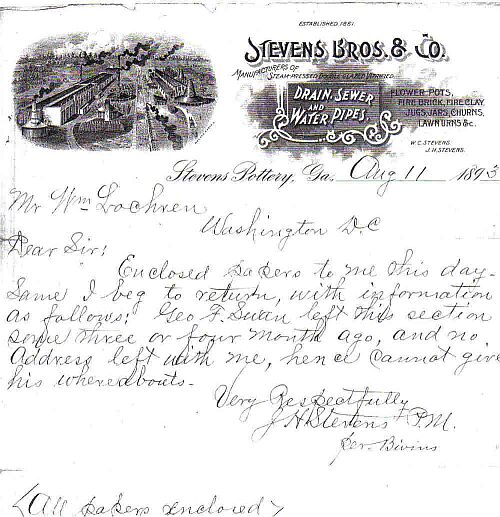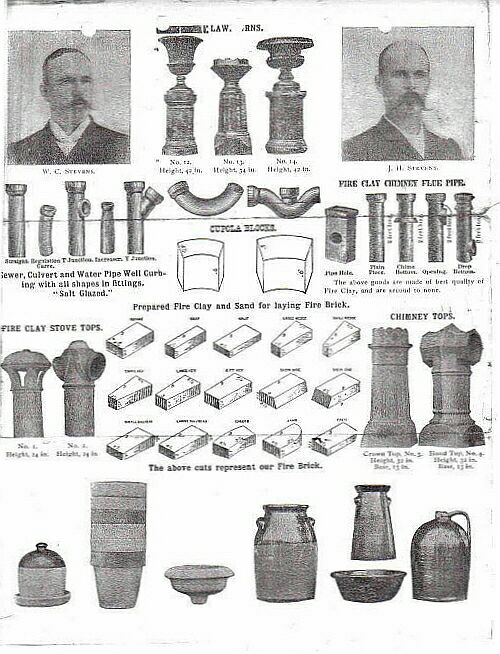Stevens Pottery
1882
April 14, 1882
The Atlanta Constitution
Stevens Pottery Ga, April 7, 1882
Last Tuesday morning your correspondent
took the Macon and Eatonton trail for this little village. At nine o'clock
he landed in the place and proceeded to take notes of the surroundings.
"The Pottery," as it is called, was settled long years ago by Mr. Henry
Stevens, and here he made money at the business, which has since engaged
his sons-Crawford, John Henry and William Park. The increasing trade, and
his declining health, made it necessary for the old man to give up most
of his business to his boys. He brought them up to work, and they were
fully competent to take charge of it. Really, the business has all passed
into their hands, and the father employs his time in traveling for the
firm.
The first thing which attracts the
attention of the stranger is an ungainly looking building, on the southeast
of the railroad. At the entrance one is saluted by "mud" -right and left.
This mud is dug up one mile from the building, and brought by the railroad
to this point. It is thrown in a pit to soak for several hours, and then
fed into the mud mill. This mill is run by a twenty-five horse power engine
in the west side of the mud-room. After passing though the mud mill the
clay is ready for the potter's use. If for drain pipe, of which large numbers
are made, it is thrown, in a large lump into a press run by the same engine
as the mud mill, and forced through a die-which may be taken off or put
on at pleasure-the size of which determines the size of the pipe. Two bands
hold the receptacle - a wooden piece curved to fit the pipe. When the proper
length has been reached the pressure is stopped, and a wire is needed to
cut off the dirt tube. To follow this particular branch further; the pipe
is taken to another room where any roughness may be smoothed off, and a
"collar" put on. This is done by standing it upon a table placing a roll
of mud around the top or collar and pressing the mud with the hand to the
size necessary to receive a pipe of the same size as the one "collared."
The pipe is taken to the "dry-pan"
a room some thirty by ninety feet square. Large flues pass through the
dirt floor, which conduct the heat to all parts of the room. This drying
prepares the pipe for the glaze vat. Here it is swung into a solution of
"blue mud." This is not ordinary mud, but is of a peculiar character, and
cost several dollars per barrel. It is shipped from Albany, New York. After
a few hours drying, it is placed in the large kiln, and burned until it
comes to a white heat. This melts the blue mud and causes it to form a
beautiful glaze. The kiln is then opened and left to cool, when the pipe
is removed to the pipe yard, where such large numbers are seen, there to
await orders. It is manufactured from two inches to two feet in diameter.
1893
 Copy of a letter that was received at the War
Department from Stephens Pottery regarding my great-grandfather, George
F. Swan who worked at the Pottery for about 8 years. They apparently enclosed
the second paper with pics of W. C. Stevens and J. H. Stevens shown with
different types of pottery made at Stephens Pottery, just because.......
They were two separate papers received by me from the War Department in
my great-grandfather's pension file. They were dated 1893.
My great-grandfather apparently moved around alot and after leaving Stevens
Pottery could not be found for a couple of years. His pension
file was over 400 pages. Tonya Crosby
Copy of a letter that was received at the War
Department from Stephens Pottery regarding my great-grandfather, George
F. Swan who worked at the Pottery for about 8 years. They apparently enclosed
the second paper with pics of W. C. Stevens and J. H. Stevens shown with
different types of pottery made at Stephens Pottery, just because.......
They were two separate papers received by me from the War Department in
my great-grandfather's pension file. They were dated 1893.
My great-grandfather apparently moved around alot and after leaving Stevens
Pottery could not be found for a couple of years. His pension
file was over 400 pages. Tonya Crosby

Submitted by Tonya
Crosby
Eileen Babb McAdams copyright 2004




